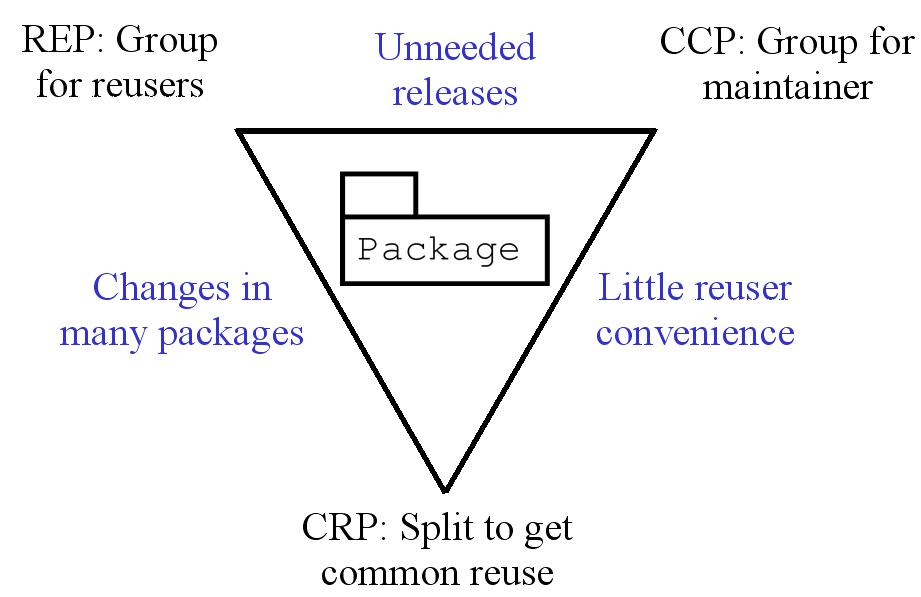CSC/ECE 517 Fall 2009/wiki3 3 cp
Common Closure Principle
In simple words the Common Closure Principle refers to classes that change together, belong together, this is a very simple definition taken from the book Java Design: Objects, UML and Process written by Kirk Knoernschild.
A more explained definition of Common Closure Principle is given by Robert Martin, which states that:
THE CLASSES IN A PACKAGE SHOULD BE CLOSED TOGETHER AGAINTS THE SAME
KIND OF CHANGES. A CHANGE THAT AFFECTS A PACKAGE AFFECTS ALL THE
CLASSES WITHIN THAT PACKAGE.
See Granularity PDF Article written by Robert Martin for more details
In other words, what affects one affects all, a broader and detailed explanations are given in this wiki work.
Introduction and Objective
There are several web pages that explain in few words what is Common Closure Principle, but they fall short by just giving definitions and very few examples.
Therefore the objective of the wiki work is to dedicate a deeper investigation on this topic with examples.
A Deeper Definition of Common Closure Principle CCP
Common Closure Principle or CCP is a design principle whose objective is to achieve maintainability, whereas usability is not important. This principle says what kind of classes should grouped or packaged together from a common change that affects all its components.
This is also called coupling in the package, however there are other design principles that advise the loose of coupling between classes, the basis of those principles are the need of change without affecting others, however as explained in granularity paper by Granularity by Robert C. Martin,
DEPENDENCIES CANNOT BE AVOIDED.
Therefore CCP identifies the classes that are totally dependent from each other, on this matter the Open-Closed Principle or OCP advises full closure which is difficult to achieve.
The previous statement leads to the overlapping of principles that shall not be confused as a violation of principles, however the decision to overlap principles in the design must be very carefully studied in the early stages.
The CCP principle recommends identifying the common changes in a package, only after that the package can be released with the functionality that a change affects all its classes; the benefit of this is "maintainability", which is easier for the user in the way that a change or update surely affects all classes in the package
For a design to be maintained a degree of volatility will be required, this is easily achieved when the CCP principle is applied in the sense that all classes in the package can change simultaneously, any package expected to be volatile should not depend on a package that is difficult to change.
Another advantage of CCP is stability of packages; to have packages with common changes makes the package itself more stable, which in the end improves stability
Examples of the Applied Common Closure Principle
One simple example are the classes that handles schedules like, Weekly schedule, Biweekly schedule, Monthly schedule, Change Schedule, etc. can form a single Package
Where a change of summer time will sure affect all classes within the package
The following is a group of classes that have the METHOD common change, they actually form another package.
Common Closure Principle from the Granularity Point of View
According to the granularity Granularity written by Robert C. Martin states that
MORE IMPORTANT THAN REUSABILITY IS MAINTAINABILITY
Think it in this way, what if an application must change, it is better to have it all in one package? Or it is better to have it spread through different packages?
Of course it is easier to have it in a single package for maintainability purposes instead of looking up trough all packages and then apply the change.
It is now clear the purpose of the Common Closure Principle, which is to gather in a package all the classes that almost always change together, conceptually they must belong a the same package for maintainability. This approach reduced the work when releasing, revalidating, and redistributing the software.
Granularity also mentions that CCP is a kind of OCP where the classes should be closed for modification but open for extension, however the closure is not always achieved, the difference with CCP is that the closure is made on the most likely kinds of changes that the designer can foresee.
Common Closure Principle From the User Point of View
As said before the CCP is more stable since the common features are grouped in packages, however it is not good for reuse, since stability carries inflexibility, Figure below explains better this trade of for the user.
Special thanks to Stefan Kluth for allowing to use the previous image from his work OO Package Design Principles
The designer must choose how to organize the packages according to his needs the Triad helps to understand the effect when applying CCP, REP or CRP (see appendix for definitions)
What are the Advantages and Disadvantages?
The first advantage is that CCP avoids dispersion of changes; the conclusion is that changes must affect the smallest number of released packages
It is easier to maintain since a particular change will affect all classes, this is another advantage from the maintainability of the design.
Another advantage is that clients can use specific interfaces instead of a single general interface.
The disadvantage is the inflexibility to reuse the design; if a new application is to be implemented the design based on CCP will be difficult to export it.
Conclusions of Applying Common Closure Principle
Classes within a package must be cohesive
- Reduces frequency of release of packages
- Confines changes to a few packages.
- Reduces package release frequency.
- Reduces work for the programmer and makes easier to maintain it.
- All classes that are likely to change for the same reason should be packaged together.
- The Common Closure Principle makes the closure strategic instead of fully closed
Reference Books
- Object-Oriented Design Heuristics by Arthur J. Riel
- Agile Principles, Patterns, and Practices in C# by Robert C. Martin; Martin Micah
- UML for Java™ Programmers by Robert C. Martin
- Java Design: Objects, UML, and Process by Kirk Knoernschild
External Links and Articles
- Bob Martin's Robert C. Martin web page
- Design Principles and Design Patterns by Robert C. Martin
- Granularity by Robert C. Martin
Appendix
- Open/Closed Principle OCP: Entities like classes or modules need to be open to extend them, at the same time they need to be closed for modification.
- Liskov Substitution Principle LSP: Any base class function must not be confused when a derived class is substituted for the base class. It is also known as "Design by Contract" principle in Robert Martin
- Dependency Inversion Principle DIP: The details must be based on abstractions and not in the other way around, abstractions based on details.
- Interface Segregation Principle ISP: Some interfaces can be grouped in member functions, in this way the clients use one group of member functions, and other clients use the other groups according to their purpose. The clients use specific interfaces instead of the general interface.
- Reuse/Release Equivalency Principle REP: Reuse and Release are almost the same in the sense that only Released components through a tracking system are Reused components.
- Common Closure Principle CCP: If the changes are of the same kind then they should be closed together, in other words, classes that change together, belong together and form groups
- Common Reuse Principle CRP: It refers to the classes that are reused together, if they are not then they should not be grouped. The effect of applying Common Reuse is that if you reuse one you reuse all of them.
- Acyclic Dependencies Principle ADP: The structure for released components must never form a dependency cycle.
- Stable Dependencies Principle SDP: this principle recommends that the dependee must be more stable than the depender; they usually follow the direction of stability.
Most of the definitions were inspired on the web page What Makes A Good Object-Oriented Design? written by Tim Ottinger


